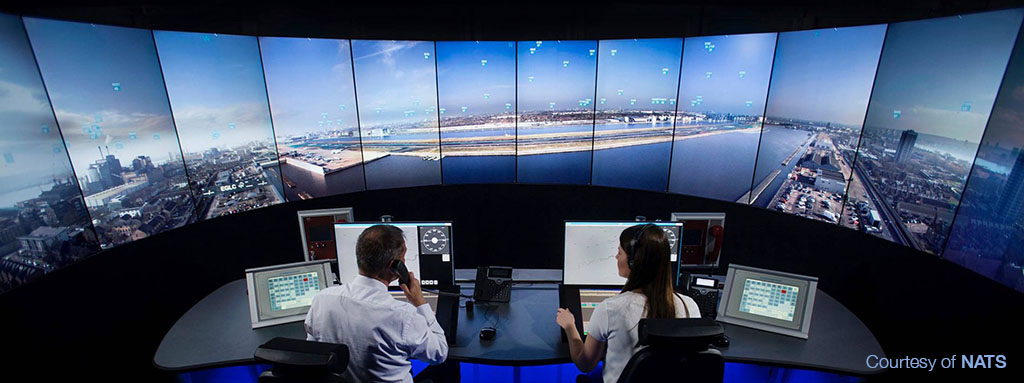Since the beginning of time, humans have always tried to optimise their tasks in such a way as to involve less physical effort and less economic investment. In all cases it is the utmost priority that these optimisations should not put physical integrity at risk. This mentality was maintained when humans learned to fly, and more especially because flying commands far more respect than other everyday tasks. This is one reason why optimisations in the aeronautical world are carried out slowly, making sure to always tread very carefully.
The technology behind the remote control of air traffic at airports has already proven its viability and safety, and it offers many advantages.
This is the case for systems of remote air traffic control in airports, known as Remote Tower Systems (RTS) or remote-control towers. The idea is based on having a Remote Tower Centre (RTC) that manages several airports, physically dispensing with standard control towers.
This system works with a series of high-definition cameras and sensors of different types located in a turret that has visibility of the entire airport that is being controlled. The data are sent in real time to the remote tower centre, which contains all the technical and human resources required for managing operations. Remote tower centres are equipped with large screens that generate a 360-degree high-definition image of each aerodrome that is being controlled. Those who already use these types of facilities affirm that, with this global image of the airport, together with the availability of other information systems that enrich what is displayed on the screens (augmented reality), operability is improved in terms of safety, security and air traffic management capacity.
One advantage that must be taken into account is the reduction of costs in air traffic control services, maintenance and associated personnel. It is estimated that these innovations can result in savings of 30-40% in these costs, which is a worthwhile justification for airports with few operations.
In this sense, the implementation of this system can seem very attractive to airport operators. With a centralised control centre, it can offer more flexible air traffic services, even on-demand services, and uninterrupted operation (24×7 service) with no increase in costs. Ultimately, it is a solution that would improve the economies of scale of certain airports, improving their profitability and efficiency without any loss of safety or security.
One of the pioneers of this technology was Örnsköldsvik Airport in Sweden, controlled from the Sundsvall Remote Tower Centre (RTC), which is 155 kilometres away from the airport. The use of this technology was approved in October 2014, although the 24-hour service did not begin until April 2015. Today, with the system fully operational, the Örnsköldsvik Airport control tower is completely empty.
The approval of the system by the Swedish authorities was a long process, taking around 10 years. Everything had to be in place for the system to integrate the highest operational safety and security standards. Following the success of the first facilities, new remote-control facilities are now being implemented at different airports in Sweden, Norway, Germany and the UK. Just this month, Jersey Airport in the Channel Islands has become the first British airport to achieve approval for operational use of a digital Remote Tower.
This technology forms part of the objectives of the Single European Sky Air Research (SESAR) research and development project in the area of air traffic management, which aims to modernise air traffic management in Europe, and which represents the technological foundation of Single European Sky. SESAR argues that RTS services can even be implemented in medium-sized airports, guaranteeing an AFIS (Aerodrome Flight Information Service) and TWR (Aerodrome Tower Control) service. In addition, a remote tower centre could serve small airports frequented by VFR (Visual Flight Rules) flights that, as they lack instrumental systems, would have a lower workload, thus reducing service costs.
The benefits of this system could be:
- development opportunity for low-traffic airports
- provision of cost-effective air traffic services
- greater efficiency in the use of human resources and infrastructures
- alternative to new construction or maintenance of control towers
- on-demand air traffic service and greater schedule flexibility to meet customer requirements
- improvement of operational safety through new technology
- low cost of contingency solutions
Air traffic controllers are essential in airports with a large volume of operations. However, the technological advance that RTS represent could be a very interesting alternative for air traffic service providers at certain airports. The main benefit could be the optimisation of technical and human resources in the control towers of smaller airports, especially during low-demand seasons or times.
As an example, we can assess the situation in Spain, where 62.5% of aerodromes have less than 60 operations a day. It does not therefore seem too far-fetched to think about implementing this technology in some of these airports.
New technologies allow access to more information and provide greater precision and immediacy of data for decision-making during airport operations. This leads to better results in terms of operational safety and airport operations.
It is not surprising that some of those involved in air transport have some misgivings about technology that excludes the direct presence of human beings in the performance of operations. However, the experiences that are already underway have demonstrated not only that it is viable, but also that it has many advantages and, above all, that it complies with the highest standards of safety and security.



